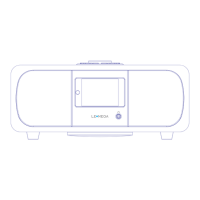8 of 30 9 of 30
2.4 Display
The screen shows various menus, dialogues and displays as
described below.
There are basically six types of screen:
Ÿ Standby (clock)
Ÿ Splash (mode)
Ÿ Now playing
Ÿ Dialogue
Ÿ Error/Information
Ÿ Menu
When text is too long to fit on the screen, it is first shown
truncated, then after a few seconds, slowly scrolls so that you
can read it all. The Standby screen shows the time, date and
any active alarm times.
As you cycle through the play modes using SOURCE, M3 shows
a splash screen for each mode. After one second, M3 enters the
selected mode and tries to start playing the last station or track
that was playing in that mode. If this is not possible, M3 tries to
connect to the selected source by scanning for stations, or
prompting for user input as appropriate.
Now playing screens show information about the audio source
and track now playing, where available.
Dialogue screens are shown to allow the user to change settings.
Error/Information screens give specific messages for a few
seconds, then change automatically to another screen.
Menus
M3 has basically three types of menu. Use the Select control to
step through and select options. A scroll bar on the right of the
screen shows if there are further options above or below those
visible.
Each mode has a Mode menu, with options specific to that mode.
Below for DAB mode menu as an example.
In addition, each mode menu has two final options:
System settings > and Main menu >.The '>' indicates options
leading to further menus.
The System settings menu allows access to system settings and
information such as time, language and software update.
Menus with more options than will fit on one screen have a scroll
bar to the right.

